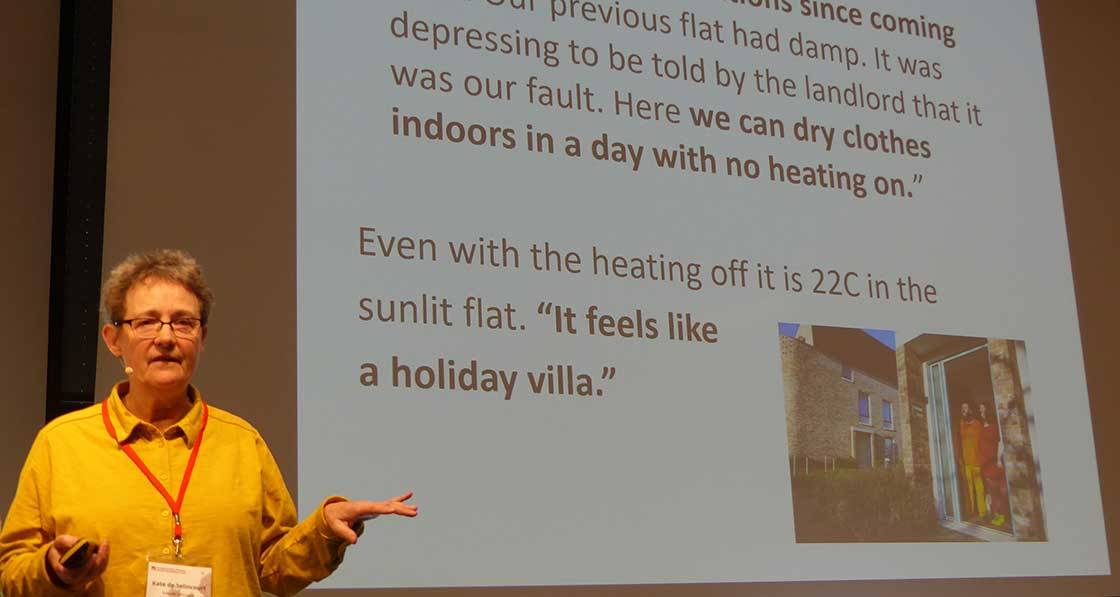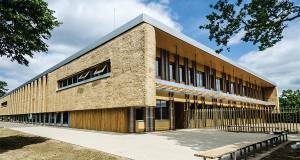
- Events
- Posted
Passive house isn’t just about efficiency – it’s about social justice
The potential of the passive house standard to change the world isn’t restricted to tackling climate change – it’s about social justice too.
This article was originally published in issue 44 of Passive House Plus magazine. Want immediate access to all back issues and exclusive extra content? Click here to subscribe for as little as €15, or click here to receive the next issue free of charge
Speaking at the 26th International Passive House Conference in Wiesbaden, Passive House Plus reporter Kate de Selincourt spoke about the role of highly energy efficient buildings in enabling lower-income communities to live in a healthy environment. "So much of the passive house is about health and well-being," said de Selincourt, who had researched the human consequences of the energy crisis in the Cold Proof series of articles in issue 43 of Passive House Plus.
De Selincourt told the conference that a growing number of British people are unable to heat their homes properly. Low-income families and elderly people have been living in winter in cold and damp buildings with room temperatures of 15 C – and sometimes even below 10 C, leading to enormous suffering and health threats. De Selincourt also told the audience about the gratitude of residents when they move into homes that meet the passive house standard.
"The heat stays in the house for a long time, and the demand for heating energy is generally low. The whole lives of these people are changed," de Selincourt said. A separate series of lectures was devoted to the topic of social housing, with projects from around the world.
The conference covered other benefits of passive house projects, such as delivering good indoor air quality in buildings with vulnerable occupants such as schools and health care buildings, and protecting the power grid against overloading.
Around 600 international participants attended the three-day conference, which was held in Wiesbaden and online. Excursions took visitors to impressive projects such as the passive house district Bahnstadt Heidelberg and the first certified passive house hospital in Frankfurt.
"It is motivating to see that a high level of energy efficiency is having a ripple effect around the world. Here we have heard about impressive large projects, also in the area of energy retrofits, which are changing lives for the better for inhabitants in the long term," said Jan Steiger, member of the management board of the Passive House Institute.
Nora Steurer of the Global Alliance for Buildings and Construction (GlobalABC), a network associated with the United Nations, pointed out that global CO2 emissions in the building and construction sector rose by five per cent in 2021 compared with the previous year. The decarbonisation of this sector must therefore be "enormously accelerated." This requires a structural change, according to Steurer.
Passive House Institute founder Prof Wolfgang Feist and director Dr Benjamin Krick highlighted the urgency of the conference’s theme, Efficiency NOW! "Unless the heating demand of buildings is reduced, the power grid won't suffice if the majority of our buildings are equipped with heat pumps", explained Krick.
Delegates also learned of Enerphit retrofit projects in Germany, Ireland, Spain, Poland and Denmark, and large scale projects such as the 18-storey Ken Soble Tower in Hamilton, Canada, which is providing 146 healthy and affordable apartments with low energy costs to the predominantly elderly residents. In northern Mexico, where summer temperatures can reach 52 C, one project provided crucial information on the feasibility and cost-effectiveness of Enerphit retrofits in emerging economies. A workshop on the EU outPHit project focused on large-scale and fail-safe deep retrofits using prefabricated components.
Municipalities were invited to attend a workshop specifically tailored to their needs, which also presented the outPHit concepts for quality assurance in retrofits to the Enerphit standard.
- Issue 44
- international passive house conference
- energy efficient design
- Irish news
- UK news
- energy crisis
- Ireland
- UK
Related items
-
 King of the castle
King of the castle -
 Energy poverty and electric heating
Energy poverty and electric heating -
 New Ejot profile cuts thermal bridging losses by 25mm insulation equivalent
New Ejot profile cuts thermal bridging losses by 25mm insulation equivalent -
 Build Homes Better updates Isoquick certification to tackle brick support challenge
Build Homes Better updates Isoquick certification to tackle brick support challenge -
 #BuildingLife Series: Director at CORA Consulting Engineers, John Casey
#BuildingLife Series: Director at CORA Consulting Engineers, John Casey -
 September’s AECB environmental construction conference seeks to spark debate among industry experts
September’s AECB environmental construction conference seeks to spark debate among industry experts

